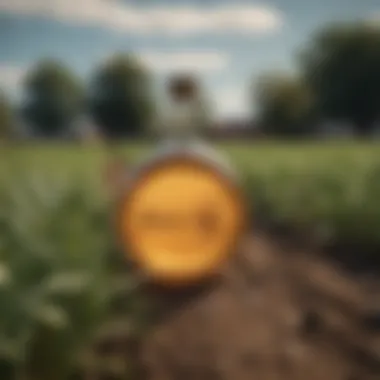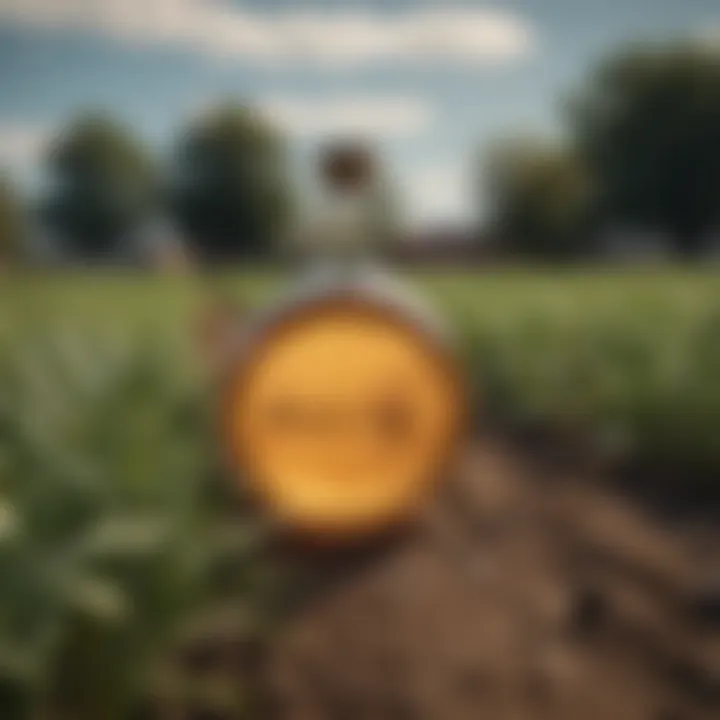An In-Depth Exploration of Monsanto's Roundup Herbicide


Intro
Monsanto's Roundup herbicide has gained significant attention in recent decades. As one of the most widely used herbicides globally, it is crucial to understand its chemical composition, practical applications, and the controversies surrounding it. This section sets the stage for exploring these complexities and examining how they relate to agricultural practices and environmental issues.
Roundup, primarily containing glyphosate, first entered the agricultural market in the 1970s. Its broad-spectrum efficacy against a variety of weeds made it appealing for farmers. However, as its use grew, so did concerns regarding its safety and environmental impact. This article will provide a comprehensive analysis of the chemical makeup of Roundup, its usage and effectiveness in agriculture, as well as the ongoing legal and health debates highlighting both its advantages and risks.
Understanding these aspects will be beneficial not only for farmers and agricultural professionals, but also for enthusiasts eager to learn more about sustainable farming practices.
Prelude to Roundup
Roundup, a widely recognized herbicide developed by Monsanto, has become a staple in modern agriculture. Its significance lies in its effectiveness against a broad spectrum of weeds, which allows farmers to cultivate crops with less competition for resources. This section aims to highlight the core aspects of Roundup, laying a foundation for the detailed discussions to follow in the article. Understanding Roundup's journey from its inception to its current status enriches the reader's comprehension of agricultural practices and debates surrounding herbicide use.
Overview of Roundup's Development
Roundup was first introduced in the 1970s. It contains glyphosate, a systemic herbicide that targets specific enzymes found in plants. This feature makes it highly effective against various weeds while posing minimal risks to crops. Over the decades, its use has expanded substantially alongside the increase of genetically modified crops, which are engineered to be resistant to glyphosate. This development has led to a significant reliance on Roundup in agricultural practices, making it a crucial focus in discussions about farming methods.
Farmers appreciated Roundup for its ease of use. It could be applied before planting, after crop emergence, or even during growth, providing flexibility in weed management. The use of Roundup also supports conservation tillage practices. This approach reduces soil erosion and improves soil health by minimizing disturbances. However, this rise in usage has not been without challenges, as instances of glyphosate-resistant weeds have begun to appear, prompting farmers to reconsider their weed management strategies.
Primary Components of Roundup
Roundup's formulation is critical to understanding how it functions. The primary ingredient, glyphosate, acts by inhibiting a specific pathway essential for plant growth and development. This pathway, known as the shikimic acid pathway, is not present in humans or animals, which is often highlighted as a safety aspect of glyphosate use.
In addition to glyphosate, Roundup contains several other ingredients designed to enhance its effectiveness. These include surfactants, which increase the herbicide's ability to penetrate plant surfaces, ensuring better absorption. The exact formulation can differ among products, with some tailored for specific crops or environmental conditions.
The importance of these components cannot be understated. A clear understanding of the chemical makeup of Roundup provides critical insights into both the benefits and potential risks associated with its use in agriculture. As farmers make choices about weed control, knowledge of Roundup's composition plays a vital role in informed decision-making.
"Glyphosate's mode of action is central to Roundup's role in modern farming, influencing how farmers approach weed management in various crops."
Through this analysis, readers will better grasp the significance of Roundup in agricultural practices, setting the stage for deeper discussions on its usage, environmental impacts, and health concerns.
Usage in Agriculture
Understanding the usage of Roundup in agriculture is crucial for appreciating its impact and implications on modern farming practices. Roundup, primarily containing glyphosate, serves as a potent herbicide that effectively controls a wide array of weeds. This section will explore its role, application techniques, and the effects it has on crop yields, offering insights important for farmers and agriculture enthusiasts alike.
Role of Roundup in Modern Farming
Roundup has revolutionized farming through its systemic nature, allowing it to be absorbed by plant leaves and transported throughout the plant. This feature makes it effective against both annual and perennial weeds. Farmers adopt Roundup because it simplifies weed management, reduces the need for multiple herbicide applications, and minimizes soil disruption.
Over the years, the shift toward glyphosate-resistant crops, like corn and soybean, has significantly changed the agricultural landscape. These crops can tolerate glyphosate application, allowing farmers to apply Roundup without damaging their crops. This resistance is a driving factor in modern agriculture, leading to increased efficacy in weed control and resulting in higher crop productivity.
Application Techniques and Best Practices
To maximize the benefits of Roundup while minimizing potential negative consequences, knowledge of proper application techniques is essential. Here are several best practices:


- Timing: Applying Roundup during the early growth stages of weeds ensures better absorption and effectiveness.
- Dilution Rates: Farmers must carefully follow recommended dilution rates to maintain herbicide efficiency while preventing over-application, which can lead to resistance.
- Spray Conditions: Ideal weather conditions play a crucial role in successful application. Calm winds and moderate temperatures prevent drift and evaporation.
- Equipment Maintenance: Regular checks on spray nozzles and calibration can enhance the precision of application.
Through these practices, farmers can harness Roundup's power effectively while addressing potential resistance issues.
Impact on Crop Yields
The consistent utilization of Roundup has been linked to substantial increases in crop yields. Many studies suggest that farmers employing glyphosate-based herbicides have experienced greater productivity compared to conventional weed management techniques. Here are some key influences on crop yields:
- Weed Control: By controlling weeds more effectively, Roundup allows crops to utilize nutrients, water, and sunlight more efficiently.
- Labor Reduction: Less labor is needed for weed management, allowing farmers to allocate resources to other critical areas.
- Crop Health: Healthy crops lead to higher-quality produce, which can mean better market prices.
Environmental Impacts
The environmental impact of Roundup is a significant aspect of its use and merits careful consideration. Understanding these effects is crucial for farmers and agricultural enthusiasts who seek to implement practices that sustain both productivity and ecological balance. The application of Roundup is not merely a practice of weed control; it has broader implications that touch on biodiversity, water ecosystems, and soil health. Hence, a detailed exploration of these elements plays a fundamental role in addressing the ongoing debate about herbicide use in modern agriculture.
Effects on Non-Target Species
The use of Roundup can indiscriminately affect non-target species, which are organisms that are not the intended subjects of herbicide treatment. Many studies have shown that glyphosate, Roundup's active ingredient, can lead to a decline in populations of various non-target insects, birds, and aquatic life. The loss of pollinators, such as bees, poses a serious threat not only to biodiversity but also to agricultural productivity, since many crops rely on these insects for pollination.
Unintended consequences can also arise in aquatic environments when herbicide drift or runoff occurs. Aquatic insects can be killed, disrupting food chains and harming species that depend on these insects for survival. Practical measures, such as buffer zones or alternative weed management strategies, can mitigate these effects, but awareness and proactive management are essential for preserving these vital species.
Aquatic Ecosystems and Pesticide Runoff
Pesticide runoff is a critical concern when discussing the environmental impacts of Roundup. When it rains, herbicides applied to fields can wash into nearby streams, rivers, and lakes, leading to contamination of aquatic ecosystems. Glyphosate remains active in water and can be toxic to fish and other aquatic organisms. Elevated levels of glyphosate can compromise the delicate balance of these ecosystems, potentially resulting in a decline in water quality and the overall health of aquatic habitats.
Addressing pesticide runoff requires diligence in management practices. Integrated Pest Management (IPM) strategies offer viable alternatives that combine biological, environmental, and chemical measures to minimize pesticide use and protect water quality. Farmers can also adopt practices such as planting cover crops to reduce erosion and runoff, which additionally enhances soil health while protecting water bodies.
Soil Health Considerations
Soil health is essential to sustainable agriculture, and the use of herbicides like Roundup has implications that can be both positive and negative. Glyphosate targets certain broadleaf and grassy weeds but does not discriminate in altering soil microbiota. Research indicates that long-term use of glyphosate may disrupt the balance of beneficial soil organisms, which are vital for maintaining soil productivity and fertility.
Healthy soil is characterized by a rich diversity of microbial life along with essential nutrients. Adopting practices that minimize herbicide reliance helps maintain this balance. Crop rotation, cover cropping, and reduced tillage are among the practices that can bolster soil vitality while minimizing the need for chemical interventions.
"The health of the soil is integral, not only to farming success but also to the overall health of the environment."
In summary, the environmental impacts of Roundup warrant substantial consideration in its application within agricultural practices. From effects on non-target species to concerns over water ecosystems and soil health, the implications are far-reaching. Engaging in sustainable practices that consider these factors will help mitigate negative impacts while promoting responsible agricultural stewardship.
Health Concerns
The examination of health concerns related to Monsanto's Roundup herbicide is crucial in this discussion. As glyphosate, the primary active ingredient in Roundup, is widely utilized across various agricultural practices, its effects on human health have sparked significant debate. With increasing reports of potential health risks, understanding this issue is important for both farmers and consumers alike. Alongside its effectiveness as a herbicide, the implications for health underscore the need for rigorous evaluation and transparency in agricultural practices.
Scientific Studies on Glyphosate
Numerous scientific studies aim to ascertain the health implications of glyphosate exposure. One of the most noteworthy assessments is by the International Agency for Research on Cancer (IARC), which classified glyphosate as "probably carcinogenic to humans" based on limited evidence in humans for the carcinogenicity of glyphosate. This classification has prompted further investigation into the potential connections between glyphosate and various types of cancer, especially non-Hodgkin lymphoma.
In addition to potential cancer risks, other research highlights links between glyphosate exposure and a range of health issues, including endocrine disruption, reproductive problems, and gastrointestinal disorders. These studies often assess occupational exposure among agricultural workers, who may encounter glyphosate more frequently than the general population. Therefore, any comprehensive analysis of health concerns related to Roundup must consider the following aspects:


- Duration and level of exposure to glyphosate
- Biological susceptibility of individuals
- Methodologies of studies conducted
"The mounting evidence of glyphosate’s potential health risks calls for a reevaluation of its use in agriculture and consumption."
Such findings necessitate continued research to better understand the full health implications of glyphosate. Increased studies can provide clearer guidelines for safe application practices, potentially leading initiatives for safer alternatives in weed management.
Regulatory Perspectives on Safety
The regulatory environment surrounding glyphosate is complex. Agencies like the U.S. Environmental Protection Agency (EPA) and the European Food Safety Authority (EFSA) have conducted their evaluations and largely determined that glyphosate poses minimal risks when used as directed. These conclusions support its continued use in agriculture. However, this perspective is not universally accepted.
Controversies persist regarding the adequacy of risk assessments and the interpretations of available data. Critics argue that the existing safety thresholds do not account for long-term exposure or agricultural workers who may interact with the herbicide more closely.
Deliberations surrounding glyphosate regulation also bring to light legal implications after several high-profile lawsuits against Monsanto. Jurisdictions in various regions have begun to reconsider glyphosate's approval status, reflecting growing public concern over potential health impacts.
The following points summarize the regulatory perspectives:
- Strength of scientific evidence supporting glyphosate's safety
- Levels of public scrutiny and legal challenges encountered
- Variations in regulatory decisions across countries, impacting global trade
Legal Controversies
The legal controversies surrounding Monsanto's Roundup herbicide represent a pivotal aspect of the ongoing debate concerning its use and safety. These controversies factor significantly into discussions regarding agricultural practices, regulatory frameworks, and public health. The impact of these legal issues extends beyond the courtroom and influences the agricultural industry fundamentally.
Litigation Against Monsanto
Monsanto has faced numerous lawsuits related to Roundup, primarily centered on allegations that glyphosate, the active ingredient, poses serious health risks. One of the most notable cases involved a school groundskeeper, Dewayne Johnson, who claimed that his cancer was caused by prolonged exposure to Roundup. In 2018, a jury awarded him a substantial sum, marking a significant moment in litigation against the corporation. This case prompted a wave of similar lawsuits from individuals claiming harm caused by Roundup exposure.
The litigation has revealed critical concerns about the safety assessments and regulatory approvals that led to glyphosate's widespread use. As lawsuits continue, the outcomes may set precedents for how agricultural chemicals are regulated moving forward. Furthermore, these legal battles draw attention to the necessity for rigorous scientific evaluations of pesticide safety, ensuring that public health is prioritized in agricultural practices.
Implications for the Agricultural Industry
The implications of these legal controversies are profound for the agricultural industry. Farmers who rely on Roundup for effective weed control face uncertainty. As litigation unfolds, many may reconsider the long-term viability of using glyphosate-based herbicides. Some of the key implications include:
- Financial Impact: Farmers may experience rising costs due to increased insurance premiums or potential liability if they are implicated in lawsuits.
- Shifts in Consumer Preferences: Growing public awareness about health risks associated with glyphosate may shift demand towards organic and non-GMO crops, impacting market dynamics.
- Regulatory Changes: As legal pressures mount, regulatory bodies may tighten restrictions on glyphosate, forcing farmers to adapt to new practices and herbicide alternatives.
"The ongoing legal disputes highlight the need for transparency and integrity in the agricultural sector, emphasizing the critical influence of consumer trust on farming practices."
Ultimately, these legal controversies signify more than just court cases; they challenge existing paradigms in agriculture and compel farmers, regulators, and consumers to rethink the future of herbicide use in their practices. Understanding these aspects can foster informed decisions that prioritize health and sustainability.
Global Perspectives on Herbicide Use
Understanding the global perspective on herbicide use is crucial in assessing the overall impact of products like Monsanto’s Roundup. This section explores the diverse regulations, cultural attitudes, and economic considerations shaping herbicide applications across various countries. The insights gained here highlight not only the challenges but also the opportunities for more sustainable agricultural practice.
International Regulation of Glyphosate
Glyphosate, the primary active ingredient in Roundup, has been subject to extensive scrutiny and varying regulations worldwide. In Europe, the European Food Safety Authority (EFSA) and the European Chemicals Agency (ECHA) have consistently reevaluated glyphosate's safety, leading to a controversial approval process influenced by public opinion and environmental activism. Meanwhile, in the United States, glyphosate remains widely used, largely due to regulatory bodies like the Environmental Protection Agency (EPA), which have concluded that it poses minimal risk when used as directed.


In countries such as Brazil and India, regulatory frameworks differ significantly. Brazil is one of the largest users of glyphosate, reflecting its pivotal role in soybean cultivation. However, public health concerns and environmental damage reports have led to renewed discussions about stricter regulations. Conversely, India has expressed caution, with local states imposing bans on glyphosate amid fears of health impacts on farmers and consumers.
These regulatory approaches can be seen as a reflection of each society's priorities. In regions facing severe agricultural challenges, the benefits of glyphosate as an effective weed control mechanism often outweigh health concerns, while countries prioritizing environmental sustainability may opt for stricter regulations to protect ecosystems. Thus, understanding the international regulatory landscape gives critical insight into how Roundup is utilized globally.
Comparative Analysis of Alternatives
As glyphosate faces increasing scrutiny, alternative herbicides and practices are gaining attention. Organic farming methods, mechanical weed management, and natural herbicides are some options being explored. For instance, products based on acetic acid or other organic compounds show promise in reducing reliance on synthetic chemicals.
- Organic Herbicides: These typically have plant-based ingredients. They are perceived as safer, although often less effective than synthetic counterparts in certain conditions.
- Mechanical Methods: This encompasses practices like crop rotation, tillage, and cover cropping, which help suppress weed growth without chemical intervention.
- Integrated Weed Management (IWM): This strategy combines chemical, mechanical, and cultural practices. IWM aims to optimize crop yields while minimizing chemical use, addressing both weed resistance and environmental impact.
While these alternatives present benefits in reducing herbicide use, they also pose challenges. For example, organic herbicides may be more expensive or less effective in large-scale operations. The transition to IWM requires significant changes in farming practices and may necessitate farmer education.
"The shift towards alternative weed management practices is not just beneficial for health and ecology but can also prove economically viable in the long run."
In summary, the global perspectives on herbicide use highlight the complexities of balancing agricultural needs with health and environmental considerations. The path forward will likely depend on collaborative efforts toward innovation and regulation that align with the best practices in sustainable agriculture.
Future of Roundup and Herbicides
The future of Roundup herbicide and similar products is crucial for the direction of agriculture and environmental management. This section examines significant developments and trends shaping herbicide use in farming. As precision in agriculture increases, the role of herbicides like Roundup must evolve to meet sustainability goals while ensuring productivity.
Innovations in Herbicide Development
Innovations in herbicide development include advanced formulations and targeted delivery systems. Researchers are exploring new active ingredients that minimize ecological impact while maintaining efficacy. This includes biotechnology approaches, such as genetically modified crops that can withstand specific herbicides, leading to reduced applications overall. Furthermore, smart application technologies leverage data from sensors and drones to optimize the use of herbicides, reducing waste and minimizing off-target effects.
- Emerging biopesticides from natural sources are gaining attention.
- Metabolic engineering is key for improving crop resistance.
- Increased usage of enzyme inhibitors can enhance selectivity.
Innovative research in this field is not only focused on efficacy but also on compliance with growing regulatory demands surrounding chemical inputs in agriculture. Key players in the industry are stepping up their research and development to stay ahead of these trends.
Potential Shifts Towards Sustainable Practices
The agricultural sector is witnessing a shift toward sustainable practices, as more farmers recognize the necessity of environmental stewardship and public health considerations. This evolving mindset is leading to diverse approaches:
- Integrated Pest Management (IPM): This method combines biological, cultural, and chemical practices, aiming to reduce reliance on herbicides. Farmers employing IPM can effectively manage pests while minimizing chemical inputs.
- Organic Farming: Growth in organic farming reflects a strong consumer demand for clean and sustainable food sources. This industry often excludes synthetic herbicides like Roundup, pushing for natural alternatives.
- Regenerative Agriculture: This approach focuses on restoring soil health, promoting biodiversity, and improving ecosystem resilience. Practices such as cover cropping and crop rotation reduce dependency on herbicides.
Finale
The conclusion serves as a vital component in understanding the multifaceted implications of Monsanto's Roundup herbicide. It encapsulates the significant themes discussed throughout the article, emphasizing the need for ongoing dialogue in agricultural practices and the broader environmental context.
Summary of Key Points
Several critical elements were explored:
- Chemical Components: The substance glyphosate is a central figure in the debate surrounding its safety and efficacy in pest management.
- Usage in Agriculture: The discussion highlighted Roundup's role in modern farming practices and its impact on crop yields, which is essential for food security.
- Environmental Effects: The herbicide's potential negative impacts on non-target species and soil health raise concerns about its long-term viability.
- Legal Controversies: Ongoing litigation against Monsanto highlights significant issues regarding accountability and regulation within the industry.
- Health Implications: The health concerns linked to glyphosate have prompted a reassessment of its regulatory status and safety guidelines.
- Future Outlook: Innovations in herbicide development and a shift toward sustainable practices are critical for the future of agriculture, ensuring that the industry adapts responsibly to emerging challenges.
This conclusion synthesizes the various threads of discourse, presenting a comprehensive view that is crucial for professionals and enthusiasts who require a nuanced understanding of Roundup and its implications in various contexts.
Final Thoughts on Herbicide Use
Herbicides like Roundup have transformed agricultural practices, allowing for increased efficiency and productivity. However, the challenges associated with its use cannot be overlooked. Questions concerning environmental stewardship, health impacts, and legal accountability demand thoughtful consideration.
Farmers must weigh the benefits of herbicide use against potential risks. Adopting more sustainable and environmentally friendly practices can mitigate negative effects and maintain agricultural productivity in the long run. It is clear that responsible use, in combination with scientific research and regulatory oversight, will play a key role in maintaining a balance between agricultural necessity and ecological health.















